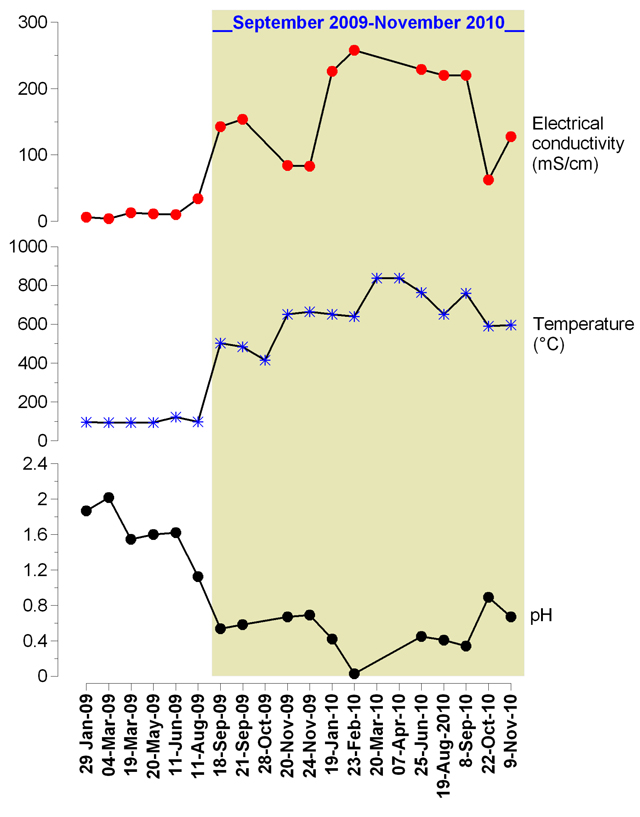Report on Poas (Costa Rica) — December 2010
Bulletin of the Global Volcanism Network, vol. 35, no. 12 (December 2010)
Managing Editor: Richard Wunderman.
Poas (Costa Rica) Occasional minor phreatic eruptions during December 2009-November 2010
Please cite this report as:
Global Volcanism Program, 2010. Report on Poas (Costa Rica) (Wunderman, R., ed.). Bulletin of the Global Volcanism Network, 35:12. Smithsonian Institution. https://doi.org/10.5479/si.GVP.BGVN201012-345040
Poas
Costa Rica
10.2°N, 84.233°W; summit elev. 2697 m
All times are local (unless otherwise noted)
This report discusses the behavior of Poás during January 2009-February 2011. Several minor phreatic eruptions occurred, and fumaroles on the dome at times had temperatures over 800°C (figures 92 and 93). As reported earlier (BGVN 34:01), earthquakes on 8 January 2009 caused a number of significant landslides and destruction; a phreatic eruption occurred on 12 January 2009.
According to the Observatorio Vulcanologico y Sismologico de Costa Rica-Universidad Nacional (OVSICORI-UNA), seismic data indicated that a phreatic eruption from Laguna Caliente, one of two summit lakes at Poás, occurred on 21 March 2009, the first one since 12 January 2009. Observation shortly after the March phreatic eruption revealed that water in Laguna Caliente was gray and measured 49°C. Convection cells disturbed in the steaming lake's central area. There was continuous bubbling along the crater's SW wall. Fumarolic activity at the N crater wall had a temperature of 93°C and emitted constant steam that rose up to 400 m above the crater floor. One of the fumaroles produced a noise similar to steam escaping from a safety valve.
In November, OVSICORI-UNA reported several phreatic eruptions from the central part of Laguna Caliente. They ejected material that fell back into the lake, occasionally producing small waves. Dark-colored gas plumes rose a few meters to several ten's of meters above the lake surface. The temperature of the lava dome was 630°C at accessible areas. Fumarolic plumes from the dome rose 1 km and drifted W and SW. Some foliage on the SW flank ~3.5 km from the crater showed signs of gas damage.
Another phreatic eruption was observed on 25 December 2009. Steam and lake water mixed with sediment and blocks were ejected 550-600 m above Laguna Caliente and fell in the vicinity of the lake, within the crater. The amount of steam emitted from lava-dome fumaroles at the S edge of the lake increased subsequent to the eruption (figure 92), and the smell of H2S was strong.
OVSICORI-UNA reported another phreatic eruption from Laguna Caliente on 23 February 2010. The eruption ejected gray and sulfur-smelling sediment onto the southern flanks. The event was seen by a scientist collecting samples in the low part of the crater and by visitors at the viewpoint area. Seismographs showed no precursory signals.
An observation of the Laguna Caliente in April 2010 noted that the water temperature was 48°C and that the water level in the lake had decreased 28 cm between 7 and 27 April 2010. The area of fumarolic activity was also noted to have increased. Two new fumaroles emerged in the N wall. They produced sulfur deposits and bluish gas emissions (temperature ~838°C) that rose ~1 km above the crater floor.
In September 2010, the temperature of the lava dome was 810°C at accessible areas. OVSICORI-UNA reported that several phreatic eruptions occurred from the central part of the lake and again, ejected material fell back into the lake and gas plumes rose up to ~100 m above the water surface.
OVSICORI-UNA reported that in November 2010 several phreatic eruptions occurred; plumes from the eruptions rose ~1 km and drifted W and SW. Some foliage on the SW flank ~3.5 km from the crater showed signs of gas damage. By this time, the temperature of the lava dome had declined to ~630°C.
According to OVSICORI-UNA, a small phreatic eruption occurred from the central part of Laguna Caliente on 2 February 2011. Solid dark material was ejected 6 m and fell back into the lake. Before, during, and after the eruption, a concentric area of the lake surface ~15 m in diameter was disturbed by a convecting cell. Bubbles of gas rose from the agitated area, and upwelling sediments were observed.
Geological Summary. The broad vegetated edifice of Poás, one of the most active volcanoes of Costa Rica, contains three craters along a N-S line. The frequently visited multi-hued summit crater lakes of the basaltic-to-dacitic volcano are easily accessible by vehicle from the nearby capital city of San José. A N-S-trending fissure cutting the complex stratovolcano extends to the lower N flank, where it has produced the Congo stratovolcano and several lake-filled maars. The southernmost of the two summit crater lakes, Botos, last erupted about 7,500 years ago. The more prominent geothermally heated northern lake, Laguna Caliente, is one of the world's most acidic natural lakes, with a pH of near zero. It has been the site of frequent phreatic and phreatomagmatic eruptions since an eruption was reported in 1828. Eruptions often include geyser-like ejections of crater-lake water.
Information Contacts: Observatorio Vulcanologico Sismologica de Costa Rica-Universidad Nacional (OVSICORI-UNA), Apartado 86-3000, Heredia, Costa Rica (URL: http://www.ovsicori.una.ac.cr/).



